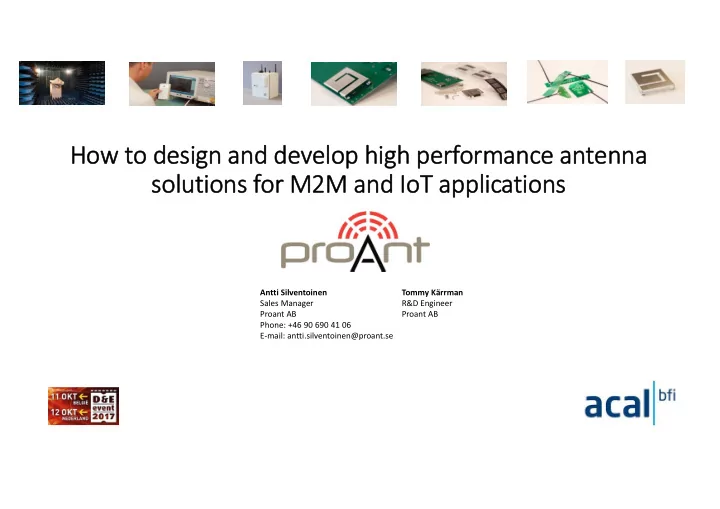

How to design and develop high performance antenna solutions for M2M and IoT applications Antti Silventoinen Tommy Kärrman Sales Manager R&D Engineer Proant AB Proant AB Phone: +46 90 690 41 06 E‐mail: antti.silventoinen@proant.se
Freedom of the antenna… For optimized performance, the antenna should be mounted externally. • Physical damage to the antenna • Size of the product • User/consumer demands • Design • Mobility of devices • Other… maybe vanity? Anything in the near proximity of the antenna, affects the radiation. …by the way, this antenna was developed by Mr Tomas Rutfors prior to him founding Proant AB.
The ”embedded dilemma” For many reasons, the antenna needs to be embedded. In particular in mobile and/or wearable devices. What are the design and engineering challenges?
Crucial features of the embedded antenna with respect to mobility • The antenna should keep on radiating within the ”right” frequency range, no matter whether the wireless device is close to dense matter (wood, concrete, metal etc) or the human body. Frequency stability. • The antenna should radiate in all directions. Since mobile devices move around, the antenna’s directionality affects the connectivity. The antenna should be as omnidirectional as possible. • Since the antennas angle relative the recieiving or transmitting counterpart changes, the polarity of the antenna affects the connectivity. Mixed polarity is beneficial.
PIFA (Planar Inverted F Antenna) – Schematics Monopole Folded monopole IFA – Inverted F Antenna PIFA – Planar Inverted F Antenna OnBoard SMD WLAN Dual band 2,4 and 5 GHz
PIFA Technology Proants planar inverted F antennas (PIFAs) • Made of sheet metal • Mounted directly on PCB From: elektronica issue 8/9 2017 • Frequency optimization by matching components • Components can be placed under the antenna • No ground cut out • Frequency stable • Omnidirectional radiation pattern • Mixed polarization • High radiation efficiency • Proant OnBoard SMD series are PIFAs Tape and reel delivery
Importance of the antenna choice/placement early entrance in your project • Customer: ‘’We have developed this product that will revolutionize the market and the demand for it is immense! Look at this great PCB design!” • Antenna supplier: “That sound great!” • Customer: “Now, all we need is a superior embedded antenna solution...” • There may be limited or no space for the antenna. • The position available for the antenna is not beneficial in an antenna performance perspective. RESULT: • The final product may end up with very poor wireless connectivity • Costly , time consuming re‐design . Lost margin, lost business, delayed market entrance.
Influence of large components/mechanics placed close to the antenna. “The 45‐degree Rule of Thumb” Note: Small components may be placed under the antenna • 45‐degree rule of thumb keep out area • Shift the antenna frequency – detune Imaginary keep out • Matching by components on the PCB zone for electrical, • Radiation measurement metal and other large components Pictures above show a Proant OnBoard SMD GPS antenna mounted on a PCB
Matching/tuning of the antenna It is common that the resonant frequency will shift during implementation in an arbitrary device. Therefore this matching may be changed for compensation of such effects. 815MHz 835MHz 855MHz 875MHz 895MHz 915MHz 935MHz 955MHz If this antenna is not matched properly, only approx 35% Total efficiency is achieved. Example: Shifting an antenna resonant frequency from 915 MHz to 868 Mhz
To sum up: How thorough you work with the antenna solution in your design can be crucial in achieving a stable wireless connection, and therefore it is one of the most important phases when designing any wireless system. Bad connectivity kills your product! • Define targets for the antenna and enter targets in an initial stage of your project. • Choose antenna technology/solution with regards to the targets and implement the antenna in your product in a position that is beneficial. • Conduct return loss and radiation measurement along the way. • Continue with the overall design of the product. Always reflect on whether a change to the design will affect the performance of the antenna. Consult your antenna supplier when in doubt – we are here to help you!
Star Wars’ Droid R2D2 by Sphero A recent release including The Proant OnBoard SMD 2400 “This is the droid you’re looking for. R2‐D2™ is an astromech droid in the Rebel Alliance from a galaxy far, far away.... The specialized tech in R2‐D2 is unlike any other droid, making it as authentic as the trusty Artoo you’ve come to know and love. Control your droid with your smart device or watch it patrol on its own. Artoo’s signature front and rear LED lights are fully functional, and an integrated speaker means the beeps and boops come right from R2‐D2 itself.” Bluetooth connection (100 foot range)
Thank you for attending! We hope to have helped you in your project. Please visit booth #5 for more information and free samples. Magnetics Cables and Connectors IoT & Wireless Power Supplies Test and Measurement Embedded Computing Photonics LEDs and Lighting Sensors Electromechanical Fiber Optics Semiconductors RF and Frequency control Imaging
Recommend
More recommend